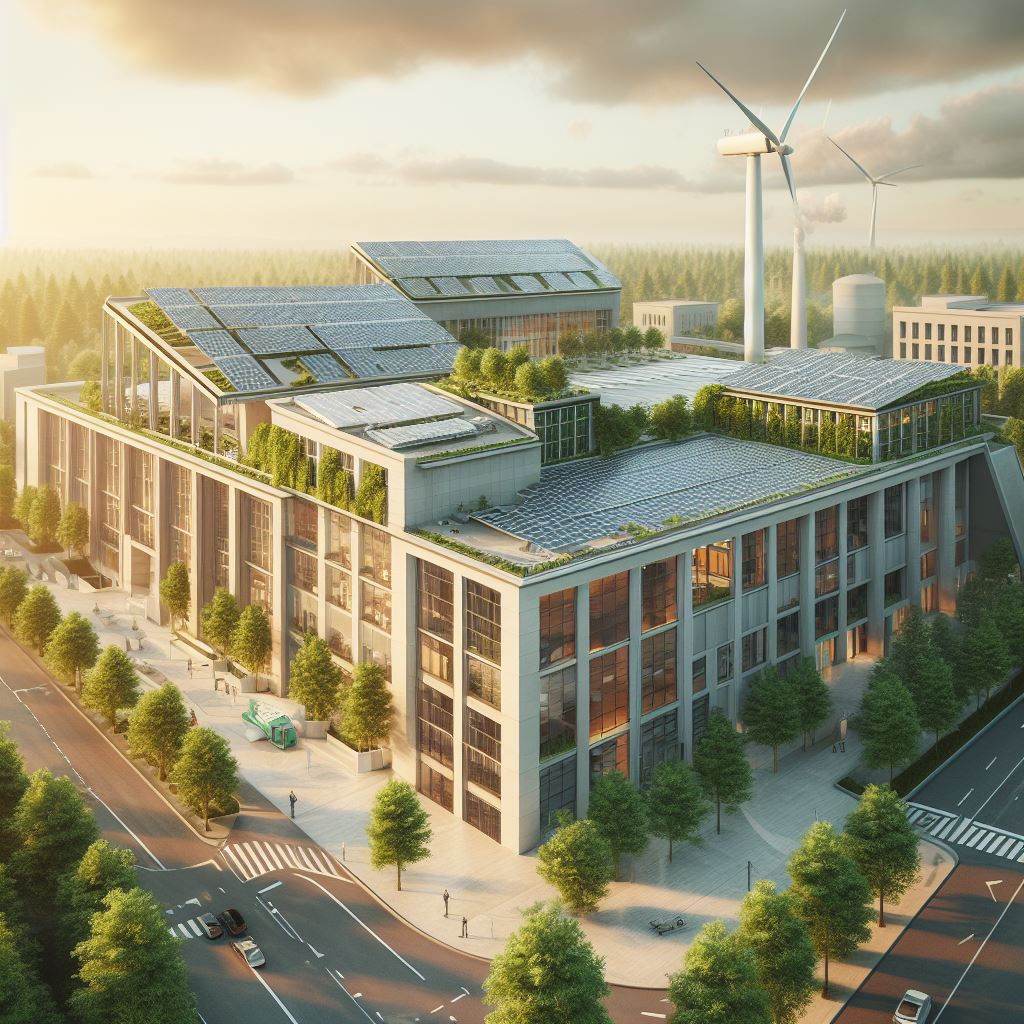US Green Building Trends: Architects Leading the Way
Last Updated on February 4, 2024
Introduction
US architects leading the way in shaping green building trends, driving innovation and sustainability in construction and design.
Green building is a vital movement in the United States, aiming to create sustainable and environmentally-friendly structures.
Architects are at the forefront of this trend, leading the way in innovation and design.
A. Green building and its significance in the United States
Green building involves using sustainable materials, energy-efficient systems, and environmentally conscious practices throughout the construction process.
Its significance lies in reducing environmental impact and promoting energy conservation.
B. The role architects play in green building
Architects play a crucial role in green building by integrating sustainable concepts into designs, such as incorporating renewable energy sources, optimizing natural light, and utilizing recycled materials.
They also ensure buildings adhere to green building certifications and standards.
Architects lead the charge in incorporating green building principles, utilizing their expertise to create environmentally responsible structures.
By employing innovative designs and technologies, they minimize waste, conserve energy, and improve indoor air quality.
Architects also consider a building’s lifecycle, from its construction to operation, to ensure its long-term sustainability.
Moreover, architects collaborate with engineers, contractors, and clients to develop energy-efficient solutions that maximize resource efficiency while maintaining functionality and aesthetics.
Their knowledge of building materials, systems, and codes ensures the successful integration of sustainable practices.
Architects also advocate for green building, raising awareness about its benefits and encouraging industry-wide adoption.
Through seminars, conferences, and research, they share best practices, inspire others, and push for more sustainable design standards.
In summary, architects are essential in driving the green building movement in the United States.
Their expertise, innovative designs, and dedication to sustainable practices are instrumental in creating a brighter and more environmentally conscious future.
The Growth of Green Building in the US
Green building practices have gained significant popularity in the United States over the past few decades.
Architects have been the driving force behind this growth, as they embrace sustainable design principles and incorporate them into their projects.
A. Statistics on the increasing popularity of green building practices
- According to the US Green Building Council, the green building market is expected to reach $248 billion by 2021.
- In 2018, 47% of surveyed architects reported that they witnessed an increase in demand for green building projects.
- The number of Leadership in Energy and Environmental Design (LEED) certified buildings in the US has surpassed 65,000.
- Green building materials market is projected to exceed $364 billion by 2022.
- In 2019, energy-efficient building practices accounted for around 40% of all new non-residential construction
B. Overview of the incentives and benefits driving this growth
- Financial incentives: State and federal governments offer tax credits, grants, and rebates to encourage green building practices.
- Energy efficiency and cost savings: Green buildings consume less energy, resulting in significant cost savings over time.
- Improved indoor air quality: Green buildings prioritize ventilation, reducing the presence of harmful indoor pollutants.
- Increased property value: Green buildings are in high demand, attracting environmentally conscious buyers and increasing resale value.
- Environmental stewardship: Green building practices reduce carbon emissions, minimize waste, and conserve natural resources.
C. Importance of reducing environmental impact in construction
Construction activities have a substantial environmental impact, accounting for a significant portion of global energy consumption and greenhouse gas emissions.
Adopting green building practices is crucial for mitigating these adverse effects and promoting sustainable development.
By using environmentally friendly materials, reducing water consumption, and incorporating renewable energy sources, architects can significantly minimize a building’s ecological footprint.
Additionally, green buildings surpass traditional structures in terms of occupant comfort and well-being.
Enhancements in indoor air quality and access to natural light contribute to improved health and productivity among building occupants.
Given the growing urgency to address climate change and promote sustainable lifestyles, architects play a pivotal role in driving the growth of green building practices.
Their designs reflect the commitment to a greener future and inspire others to follow suit.
As the demand for sustainable buildings continues to rise, architects must stay up-to-date with the latest green building trends, technologies, and certifications.
By doing so, they ensure that their designs are not only aesthetically pleasing but also environmentally responsible.
Architects are custodians of the built environment, and their adoption of green building practices sets an example for others in the industry.
Their leadership in sustainable design creates a positive impact on the planet, benefiting current and future generations.
In fact, the growth of green building in the US can be attributed to the increasing popularity of sustainable design, driven by architects who prioritize environmental stewardship.
With incentives and benefits supporting this shift, reducing environmental impact in construction becomes both a responsibility and an opportunity for architects to lead the way towards a more sustainable future.
Read: Evolution of Software Engineering in the US: A History
Architects as Pioneers of Green Building
Architects have emerged as pioneers of green building, leading the way towards a sustainable future.
Through their innovative designs and commitment to sustainable design principles, architects have significantly contributed to the growing movement of green building.
A. How architects have embraced sustainable design principles
Architects have fully embraced sustainable design principles in their practice, recognizing the importance of minimizing environmental impact and promoting energy efficiency.
They incorporate elements such as passive design strategies, renewable energy systems, and environmentally friendly materials to create buildings that are both aesthetically pleasing and environmentally responsible.
B. Examples of notable green buildings designed by architects
Notable green buildings designed by architects serve as remarkable examples of their dedication to sustainable design.
One such example is the Bullitt Center in Seattle, designed by The Miller Hull Partnership.
This building showcases sustainable features like rooftop solar panels, rainwater harvesting, and a geothermal heat pump system.
It is also one of the first buildings to achieve Living Building Challenge certification, a rigorous standard for sustainable development.
Another remarkable green building is the Edge in Amsterdam, designed by PLP Architecture.
This building is not only energy-efficient but also intelligent, with an array of smart technologies.
It utilizes rainwater for irrigation, incorporates renewable energy sources, and boasts a highly efficient building envelope.
The Edge has received the highest sustainability rating in the world, BREEAM Outstanding.
C. Industry certifications and accrediting bodies for sustainable architecture
The incorporation of industry certifications and accrediting bodies has played a crucial role in promoting sustainable architecture.
Organizations such as the U.S. Green Building Council (USGBC) and its LEED (Leadership in Energy and Environmental Design) certification have become widely recognized and respected.
Architects strive to design buildings that meet LEED standards, earning various levels of certification based on the sustainability features incorporated.
Other important certifications in sustainable architecture include the WELL Building Standard, which focuses on enhancing occupants’ health and well-being, and the Living Building Challenge, mentioned earlier, which aspires to create buildings that function as self-sufficient, regenerative systems.
These certifications and accrediting bodies not only provide guidelines for architects but also enable buildings to be recognized for their sustainability achievements.
They encourage architects to continuously improve their design strategies and foster healthy competition in the industry, resulting in better and more sustainable buildings.
In short, architects have truly emerged as pioneers of green building, leading the way towards a more sustainable future.
With their embracing of sustainable design principles, the creation of notable green buildings, and the incorporation of industry certifications and accrediting bodies, architects have been instrumental in promoting and advancing sustainable architecture.
Their efforts have not only transformed the built environment but also inspired others to follow in their footsteps, creating a greener and more sustainable world for generations to come.
Read: Exploring the Role of a Civil Engineer in the USA

Explore Further: Challenges & Rewards: Life as an Electrical Engineer in the U.S.
Key Trends in Green Building Led by Architects
1. Sustainable Materials
Architects are increasingly using eco-friendly and recycled materials in construction, reducing the environmental impact.
The use of sustainable materials offers numerous benefits such as improved indoor air quality and reduced energy consumption.
Constructing projects using sustainable materials also presents challenges, which architects must address through innovative techniques.
Some architects have showcased their creativity by designing buildings made entirely of recycled materials, setting a trend in green construction.
2. Energy Efficiency
Architects recognize the importance of designing buildings with low energy consumption to combat climate change and reduce utility costs.
Many architectural design techniques and technologies are employed to achieve energy efficiency, including passive solar design and efficient insulation.
Case studies of energy-efficient architectural designs demonstrate how implementing these techniques can drastically reduce energy consumption.
3. Water Efficiency
Conserving water is crucial in the built environment, and architects play a significant role in implementing water-efficient solutions.
Architectural designs now incorporate features like rainwater harvesting systems to collect and reuse water effectively.
Green building practices promote water-saving measures such as low-flow plumbing fixtures and water-efficient landscaping.
4. Biophilic Design
Biophilic design is a concept that integrates nature into architectural projects, providing immense physical and mental health benefits.
Architects are creating spaces that reconnect people with nature, utilizing elements like natural light, green rooftops, and indoor gardens.
Through biophilic design, architects are fostering a deeper connection between humans and their surrounding natural environment.
In essence, architects are at the forefront of green building trends, leading the way in sustainable materials, energy and water efficiency, and biophilic design.
Their innovative approaches and utilization of eco-friendly technologies and techniques are transforming the construction industry and helping create a more sustainable future.
Read: How to Become a Licensed Civil Engineer in the US
Challenges Faced by Architects in Green Building
Architects play a crucial role in the advancement of sustainable design and green building practices.
However, they often face several challenges that hinder their efforts to create a more sustainable built environment.
These challenges include:
A. Lack of awareness and misconceptions about green building practices
- Many individuals, including clients and other professionals in the construction industry, lack awareness about the benefits and possibilities of green building.
- There are common misconceptions that green building practices are expensive, impractical, or aesthetically unappealing.
- Architects face the challenge of educating their clients and stakeholders about the true value and potential of green building.
B. Higher upfront costs associated with sustainable design
- One of the major challenges faced by architects is the higher initial investment required for sustainable design.
- Green building materials, technologies, and strategies often come with a higher price tag compared to conventional alternatives.
- Architects must find ways to convince their clients that the long-term benefits, such as energy savings and reduced maintenance costs, outweigh the upfront expenses.
C. Overcoming resistance from traditional stakeholders in the construction industry
- The construction industry, which has traditionally operated using conventional practices, can be resistant to change.
- Architects face challenges when it comes to convincing contractors, suppliers, and other stakeholders to adopt green building practices.
- Resistance may stem from a lack of understanding, fear of additional costs, or unfamiliarity with new technologies and methods.
Despite these challenges, architects continue to lead the way in promoting and implementing sustainable design.
They have developed strategies to overcome these hurdles and create innovative green buildings that benefit both the environment and occupants.
Some of the strategies architects employ to address these challenges include:
1. Educating clients and stakeholders
- Architects invest time and effort in educating their clients and stakeholders about the benefits of green building practices.
- This includes sharing case studies, research findings, and success stories to dispel misconceptions and build awareness.
- Architects also collaborate with sustainability consultants and experts to provide comprehensive information and guidance.
2. Showcasing the economic benefits
- Architects emphasize the economic advantages of green building, such as reduced operational costs and increased property value.
- They present cost-benefit analyses and life-cycle assessments to demonstrate the long-term financial benefits of sustainable design.
- By highlighting the potential return on investment, architects help overcome concerns regarding higher upfront costs.
3. Collaborating with industry professionals
- Architects work closely with other professionals in the construction industry to create a cohesive approach to green building.
- They engage contractors, suppliers, and engineers early in the design process to ensure proper implementation of sustainable practices.
- By fostering collaboration and collective responsibility, architects overcome resistance and promote a culture of sustainability.
In review, architects face various challenges in promoting and implementing green building practices.
However, their determination, creativity, and collaboration with stakeholders allow them to overcome these hurdles and create a more sustainable built environment.
Read: US Civil Engineering: Industry Trends & Future Outlook
Learn More: Civil Engineers & Natural Disasters: US Response & Preparedness
Conclusion
Architects have been at the forefront of driving green building trends in the US through their leading role in designing sustainable structures and advocating for eco-friendly practices.
Throughout this blog section, we have highlighted the various ways architects have contributed to the growth of green buildings in the country.
From incorporating renewable energy sources to utilizing recycled materials, architects have embraced innovative approaches to minimize the environmental impact of construction projects.
Furthermore, architects have played a crucial role in promoting collaboration and sharing of knowledge within the industry.
By participating in green building initiatives and organizations, they have fostered an environment of learning and continuous improvement.
Their dedication to sustainable architecture has not only influenced the design and construction industry but has also had a positive impact on the environment and the health of individuals living in these green buildings.
Moving forward, it is essential for architects to continue pushing the boundaries of sustainable design.
The future of green building lies in their ability to innovate and adopt new technologies and practices that further reduce the carbon footprint and enhance the efficiency of buildings.
Lastly, architects will continue to play a pivotal role in shaping the future of green building.
Their expertise and commitment to sustainability will be integral to achieving the widespread adoption of eco-friendly practices in the construction industry.
As we look ahead, it is clear that architects will be the driving force behind the continued growth and evolution of green building trends in the US, ensuring a more sustainable and environmentally friendly future for generations to come.


